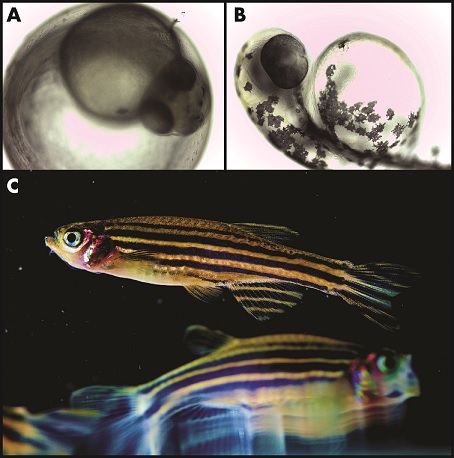The “who, when, and where” of gene expression defines everything about an organism, from development to death. Yale researchers in the lab of Antonio Giraldez, professor of Genetics at the Yale School of Medicine, have developed a new technique to probe this fundamental process.
Gene expression refers to the transcription of DNA into mRNA messages, the transcriptome, which can then be translated into a multitude of proteins with varying functions. The ability of mRNAs to reach the ribosome for protein translation is swayed by a vast array of regulatory steps. Ultimately, a decision must be made about whether an mRNA is destroyed and its message is lost, or if it will survive, be translated into protein, and help define the function of a particular cell.
The mRNA’s precarious position between life and death plays an especially important role during embryonic development. In a mechanism common to all animals, maternally-derived mRNA controls the very earliest stages of development. However, at a critical point, known as the maternal-to-zygotic transition (MZT), embryonically-derived mRNA takes charge, and the maternal mRNA is destroyed. To build upon our understanding of this basic process, we must decipher the code that dictates an mRNA’s lifespan.
What is this code exactly? Short nucleotide sequences within the start and end of mRNA messages that don’t encode protein, known as the untranslated regions (UTRs), act as binding hubs for regulatory protein players and even other RNAs (microRNAs). It is the interaction with these regulatory factors that determines whether an mRNA will be destroyed. If a UTR regulatory sequence stabilizes mRNA, that message will be preserved and the number of copies will be high; if the sequence destabilizes it, the number of copies will drop.
Although this might seem straightforward at first, the reality is much messier: multiple, overlapping regulatory sequences may be present in a single mRNA’s UTR; that single mRNA might be one of hundreds of different mRNAs in a single cell; and that cell might be one of millions of cells in an organism. What’s more, all of this must be coordinately controlled across an organism’s body during development.
To effectively probe this dizzying complexity, we need tools that will allow us to identify new UTR regulatory sequences and probe their functional relevance in living organisms at different times and in different tissues. In the 2016 Nature Methods paper, the Giraldez group describe a new technique called RNA-element selection assay (RESA) that interrogates UTR regulatory sequences in this way. “We wanted to decipher the regulatory ‘code’ within mRNA sequences that influences their stability,” said Carter Takacs, co-first author of the paper and postdoctoral fellow in the Giraldez lab.
The RESA method gives researchers a glimpse into the unknown by pinpointing previously hidden UTR regulatory sequences in a wide range of contexts, from cells grown in a dish to whole organisms. To perform RESA, a researcher isolates an organism’s UTRs and chops them up into small pieces; each of these individual pieces might correspond to an unidentified regulatory sequence. By breaking the long UTRs into these small pieces, a researcher can determine which specific portions of a UTR regulate the lifespan of its host mRNA. This is also what makes RESA so exceptionally useful. Other techniques often require testing one sequence at a time. “The RESA method allows researchers to simultaneously measure the stability of millions of distinct sequence elements within the same organism,” Takacs said.
The millions of potential regulatory UTR sequences are then put into mRNAs and introduced into an organism of choice. In this case, the mRNAs were applied to the model organism zebrafish. Once inside the zebrafish egg, these mRNAs will then either be stabilized or destroyed. High throughput sequencing of RNAs later isolated from the fish can then measure which, and how many, mRNAs were able to survive the tumult of in vivo regulation, thereby identifying the UTR sequences that promoted mRNA stabilization or destruction. Using RESA, Giraldez’s group has already identified hundreds of previously unknown UTR regulatory sequences that influence MZT.
“We now have a method to dissect the regulatory language written into mRNA sequences that determines how long an mRNA will persist in the cell. With this in hand, we can now start to identify the decay or stabilizing factors that recognize, or ‘read’, these sequence elements,” Takacs said. Indeed, the researchers have even developed a complementary method that combines RESA with an existing technology to identify these regulatory protein factors. Takacs believes RESA can expand our understanding of many aspects of RNA regulation. “The power of RESA lies in the ability to select for mRNA sequences that behave in a particular way. In the current study, we were particularly interested in RNA stability. However, we envision similar strategies to identify RNA sequences that influence other aspects of RNA biology such as mRNA translation and/or RNA localization,” Takacs said.
This will not only be useful for understanding basic biological phenomena like embryonic development but may also advance our understanding of human disease as well. “RESA could be applied to many other contexts, especially those in which cells adopt new fates or behaviors, both during normal development as well as in diseases such as cancer. In all likelihood, regulation of mRNA stability plays an important part in facilitating these switches” Takacs added. Drastic changes in gene expression occur when a healthy cell transforms into a cancer-promoting tumor cell. In fact, cancer-promoting genes can be activated by altered mRNA regulation. A number of other diseases have been linked to faulty mRNA regulation as well, including Alzheimer’s disease, inflammatory diseases, and a number of genetic diseases.
Though we’re just beginning to crack the code of mRNA regulation, advances in technology like RESA will push our knowledge ever forward and help us decipher the language of our cells.
Featured Image: The model organism zebrafish (Danio rerio) develops in an egg (A), hatches (B), and continues to mature into the adult fish (C). Images modified from Nikita Tsyba, Wikimedia Commons (A,B) and Uri Manor, NICHD, Flickr (C).

